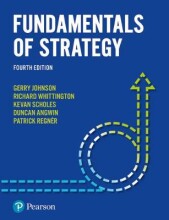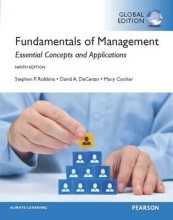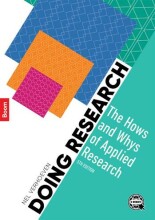Summary: Fundamentals Of Strategy | 9781292209067 | Gerry Johnson, et al
- This + 400k other summaries
- A unique study and practice tool
- Never study anything twice again
- Get the grades you hope for
- 100% sure, 100% understanding
Read the summary and the most important questions on Fundamentals of Strategy | 9781292209067 | Gerry Johnson, Richard Whittington, Kevan Scholes, Duncan Angwin, Patrick Regnér
-
1 Introducing strategy
-
1.2.1 Defining strategy
This is a preview. There are 1 more flashcards available for chapter 1.2.1
Show more cards here -
What are the different definitions of strategy?
- The determination of the long-run goals and objectives and the adoption of courses of action and the allocation of resources necessary for carrying out these goals.
- Competitive strategy is about being different. It means deliberately choosing a different set of activities to deliver a unique mix of value.
- Strategy is a firm's theory about how to gain competitive advantages.
- Strategy is a pattern in a stream of decisions.
- Strategy is the long-term direction of an organization.
-
Explain the three horizons framework.
It suggests that organizations should think of themselves as comprising 3 types of business or activity, defined by their "horizons" in terms of years. Main point is that managers need to avoid focusing on short-term issues.- Horizon 1 businesses need defending and extending, expectation is that they will be flat or decline in terms of profit.
- Horizon 2 businesses are emerging activities that should provide new sources of profit.
- Horizon 3 possibilities, for which nothing is sure. Might generate profit a few years from now.
- Horizon 1 businesses need defending and extending, expectation is that they will be flat or decline in terms of profit.
-
1.2.2 The purpose of strategy: mission, vision, values and objectives
This is a preview. There are 2 more flashcards available for chapter 1.2.2
Show more cards here -
In what 4 ways can an organization's purpose be defined?
- Mission statement - aims to provide employees and stakeholders with clarity about what the organization is fundamentally there to do.
- Vision statement - is concerned with the future the organization seeks to create.
- Corporate values - communicate the underlying and enduring core 'principles' that guide an organization's strategy and define the way that the organization should operate.
- Objectives - statements of specific outcomes that are to be achieved.
-
1.2.3 Strategy statements
This is a preview. There are 1 more flashcards available for chapter 1.2.3
Show more cards here -
What should be the main themes of the strategy statement?
- The fundamental goals (mission, vision or objectives)
- The scope or domain of the organization's activities
- The advantages or capabilities the organization has to deliver all of the above.
-
Explain the scope and the advantage part of the strategy statement.
- Scope - refers to: customers, geographical location and extent of internal activities.
- Advantage - describes how the organization will achieve the objectives it has set for itself in its chosen domain.
-
1.2.4 Levels of strategy
-
At what 3 different levels can strategies exist inside an organization?
- Corporate level strategy - concerned with the overall scope of an organization and how value is added to the constituent businesses of the organizational whole.
- Business-level strategy - about how the individual businesses should compete in their particular markets.
- Functional strategies - concerned with how the components of an organization deliver effectively the corporate- and business-level strategies in terms of resources, processes and people.
-
1.3 The exploring strategy framework
-
Explain the Exploring Strategy Framework
It includes:- Understanding the strategic position of an organization
- Assessing strategic choices for the future
- Managing strategy in action
-
Why is the exploring strategy framework not linear but circular?
Because often choices have to be made before the strategic position is clear and none has priority over the other. -
1.3.1 Strategic position
-
Explain the strategic position part of the exploring strategy framework.
Strategic position is concerned with the impact on strategy of the:- Macro environment, relates to opportunities and threats.
- Industry, relates to opportunities and threats
- Resources and competences, relates to strengths and weaknesses.
- Stakeholders
- Culture
-
1.3.2 Strategic choices
-
Explain the strategic choices part of the exploring strategy framework.
Strategic choices involve the options for strategy in terms of both the directions in which strategy might move and the methods by which strategy might be pursued:- Corporate strategy, relates to the degree of diversification.
- Business strategy
- International
- Entrepreneurship
- Acquisitions and alliances
- Higher grades + faster learning
- Never study anything twice
- 100% sure, 100% understanding
Topics related to Summary: Fundamentals Of Strategy
-
Macro-environment analysis - PESTEL analysis - PESTEL factors
-
Macro-environment analysis - Forecasting - Forecast approaches
-
Macro-environment analysis - Scenario analysis
-
Industry and sector analysis - The competitive factors
-
Industry and sector analysis - Industry dynamics - Industry structure dynamics
-
Industry and sector analysis - Competitors and makets
-
Resources and capabilities - Distinctive resources and capabilities as a basis of competitive advantage
-
Resources and capabilities - Diagnosing resources and capabilities
-
Resources and capabilities - Dynamic capabilities
-
Stakeholders and culture - Stakeholders
-
Stakeholders and culture - Owners and governance - Ownership models
-
Stakeholders and culture - Owners and governance - Corporate governance
-
Business strategy and models - Generic competitive strategies
































